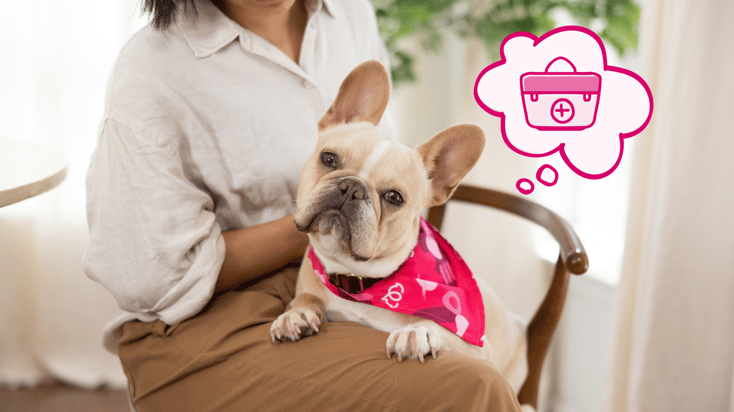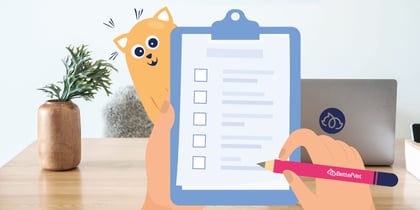Preparing a Pet for a Home Vet Visit: 9 Essential Tips

Table of Contents
Home veterinary visits are changing the game for pet care, allowing our furry friends to receive expert medical attention without leaving their favorite lounging spot. Gone are the days of stressful car rides or anxious waiting room moments!
But as with all good things, preparing a pet for an in-home visit makes things even smoother. Setting the stage for your pet and the veterinarian helps to achieve a successful checkup, ensuring everyone's comfort.
Here's how to prepare your pet for an at-home vet visit:
1. Gather Medical Records
Before the veterinarian arrives, it's a good idea to have your pet's medical history on hand. This includes previous visit summaries, vaccination cards, and any prescribed medication details.
A comprehensive view of your pet’s health journey helps the veterinarian offer the best care possible.
2. Designate a Safe Place
Choose a quiet and familiar space in your home for the veterinarian’s visit. This could be your living room, a spacious bedroom, or any area your pet feels relaxed in.
Make sure that the area is clear so that there is room for the veterinarian to examine your pet as well as no hiding places. Close doors to other spaces to ensure your pet is present when the veterinarian arrives.
🏆 The goal is to keep the environment calm and stress-free.
3. Stock Up on Supplies
Have essentials like treats, toys, or even their favorite blanket ready. These items can comfort or distract your pet during the examination.
Remember to keep things like favorite treats, towels, muzzles or crates (for pets that might become anxious), and leashes within reach.
4. Prepare Your Questions
Like a regular veterinary visit, you'll want to maximize the time you have. Jot down any questions or concerns you might have about your pet’s health or behavior.
Being proactive ensures you don’t forget to address any pressing issues.
5. Communicate with Your Veterinarian
It’s important to communicate with your veterinary team before your home visit. Let them know if your dog or cat tends to become highly anxious or tries to bite.
Share anything other information you think is important for your veterinarian to know about your pet. This helps your team to prepare in advance and be better equipped for the safety and care of your pet.
6. Keep Distractions at Bay
Reduce potential stressors by minimizing disruptions. This might mean keeping other pets away, turning off loud appliances, or letting family members know in advance so they can either be present or give space as needed.
7. Practice Calming Techniques
Some pets are naturally more anxious than others. If your pet tends to get stressed, consider calming techniques.
This could include playing some gentle music, using pheromone sprays, or introducing them to a calming collar before the veterinarian’s arrival.
Does My Dog Have Anxiety?
1. Does your dog bark a lot when you’re not at home?
2. Is your dog panting a lot more than usual?
3. Is your dog destructive when left alone (chewing, digging, or shredding)?
4. Is your dog having accidents inside the house more than usual?
5. Is your dog drooling more than usual?
6. Is your dog shedding or losing hair in patches more than usual?
7. Does your dog seem like they are on high alert (can’t relax, overly watchful, or pacing)?
8. Is your dog demonstrating repetitive behaviors (spinning, digging, biting their paws or tail)?
9. Has your dog experienced sleep changes recently (sleeping a lot more or less than usual)?
View Results
Does My Dog Have Anxiety?
1. Does your dog bark a lot when you’re not at home?
2. Is your dog panting a lot more than usual?
3. Is your dog destructive when left alone (chewing, digging, or shredding)?
4. Is your dog having accidents inside the house more than usual?
5. Is your dog drooling more than usual?
6. Is your dog shedding or losing hair in patches more than usual?
7. Does your dog seem like they are on high alert (can’t relax, overly watchful, or pacing)?
8. Is your dog demonstrating repetitive behaviors (spinning, digging, biting their paws or tail)?
9. Has your dog experienced sleep changes recently (sleeping a lot more or less than usual)?
Share Quiz
8. Familiarize Your Pet with the Veterinarian
Let your pet have a casual meet-and-greet with the veterinarian before diving into the medical procedures. A simple hello, accompanied by a treat from the veterinarian, can set a positive tone for the actual checkup.
Our veterinarians use a Fear Free® approach, ensuring a calm and friendly start to each visit.
9. Provide Quiet Time Post Appointment
After the veterinarian leaves, give your pet some quiet time or a favorite activity to help them relax. Monitor them to ensure there are no post-visit issues and reward them with a treat or play session.
Conclusion
Bringing the veterinarian into your home isn't just about convenience—it's about creating an ideal environment for pet care.
In the familiar and relaxed home setting, your pet remains calm, making it easier for the veterinarian to get an accurate read on their health. For all the busy pet parents, home veterinary services save time and reduce stress, taking out the hectic trips to the clinic.
Remember, when your pet is comfortable, they can truly be themselves, making each checkup much more effective.
Ready to make veterinary visits cozy and hassle-free? Book a home vet visit with BetterVet and let your furry friend receive the gentle care they deserve in their favorite place—their home!
Get Your Pet’s Health Checked Out at Home
Say goodbye to stressful vet visits and hello to a comfortable wellness exam in your pet's favorite spot.






